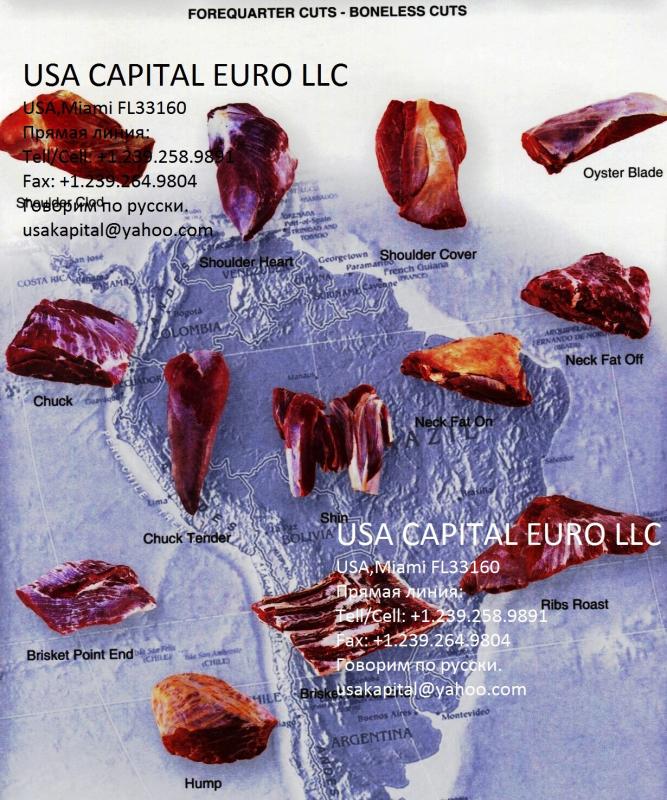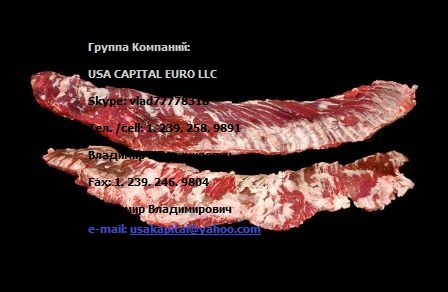Наша Продукция, Говядина, Канада, США, Бразилия, Аргентина
Наша Продукция, Говядина, Канада, США, Бразилия, Аргентина
Поставки от USA CAPITAL EURO LLC:
1. Продукция Свинины, Говядины, Курятины
2. Предоставим Квоты на ввоз мяса на территории стран таможенного союза
This industry is now dominated by a handful of huge corporations that process most of the country's meat at enormous facilities, and consolidation continues to increase.
As of 2008, four companies controlled the processing of over 80% of the country's beef and three of these same four companies (along with an additional fourth) process over 60% of the country's pork. Additionally, the four major companies in broiler chicken processing provide over half of the country's chicken supply. It is the same situation for turkey meat. In 2002, 79 percent of cattle slaughters (approximately 22.6 million) occurred at only 22 plants. As a result of this concentration, meat packing companies have become increasingly powerful, while the government bodies that regulate them have done little to keep them in line.
When animals are slaughtered and processed (the meat is cut up and packaged), several dangerous elements come into play. The first is the presence of fecal matter from slaughtered animals, which can contaminate meat with high levels of bacteria such as E. coli. Other sanitation lapses can also contaminate food, as can other animal diseases like salmonella and campylobacter. Another food safety hazard is the risk from mad cow disease (a key step to preventing humans from contracting the disease is the proper removal of risky nervous system materials from the beef supply). And in addition to these food safety risks, the use of hazardous machinery and sharp knives can injure workers when mistakes are made.

Food Safety
Federal health authorities have estimated that foodborne diseases sicken 76 million people, cause 325,000 hospitalizations, and kill 5,000 Americans every year. Likewise, a number of studies have confirmed the presence of harmful bacteria in meat in the US. After collecting ground beef samples from meat processing plants around the country in 2002, the USDA determined that 7.5% of the beef samples were contaminated with Salmonella, 11.7% were contaminated with Listeria monocytogenes, 30% were contaminated with Staphylococcus Aureus, and 53.3% were contaminated with Clostridium perfringens.
These unacceptable levels of contamination are caused by the filthy conditions in which conventional food animals are raised, as well as the high speed at which meat is processed. In order to maximize profits, meat processors have continually increased the speed of their production lines. Twenty years ago, meatpacking plants slaughtered about 175 cattle an hour, but, due to increased line speeds, today plants can slaughter as many as 400 cattle per hour.
In order to assure the safety of the meat supply, processors must make efforts to keep feces from spreading from the animals' intestines or hides onto the tables and tools for butchering, along with the meat itself. But because the production lines are forced to move so quickly, it is exceedingly difficult to butcher the carcasses with the care necessary to prevent this kind of contamination. The result is meat contaminated with bacteria that cause foodborne illness.

The US continues to experience periodic outbreaks of foodborne illness and large recalls of contaminated meat. In 2002, ConAgra was forced to recall 19 million pounds of beef produced at its Greeley, Colorado, processing facility after meat contaminated with E. coli killed a woman and sickened 35 others. By the time the meat was recalled, about 80% of it had already been consumed. Out of all foods, ground beef is the leading source of E. coli infections in the US.
The USDA publishes meat recalls issued voluntarily by companies, many of which are classified as Class I recalls, or those which are intended to notify the public about "a health hazard situation in which there is a reasonable probability that eating the food will cause health problems or death". These recalls can range in size from 100 pounds to several hundred thousand pounds of product. In 2008, the USDA published the largest meat recall in history: 143 million pounds of beef. This particular recall centered on beef that was not likely to cause illness and much of which was likely consumed by the time the recall was initiated. However, recall was initiated because of violations of animal care regulations taking place at the Hallmark Meat Packing Company in Chino, California, from where the meat originated. This incident spurred remarks from the head of the Senate Agricultural Committee to encourage a tightening of the laws for slaughterhouses. In 2007, two other major meat recalls occurred. United Food Group issued a recall of 5.7 million pounds of fresh and frozen beef and Topps Meat Company issued a recall of 21.7 million pounds of beef. Both were a reaction to possible E.Coli contamination.

Meat Inspection
The US Department of Agriculture (USDA) regulates all meat production and sale in the US, and meat is the only consumer product in the US that comes with a government seal of approval on the package. All meat for commercial sale is produced with government employees present to protect the interests of consumers. But despite its mandate to act in the interests of consumer safety, the USDA has failed to effectively assure the safety of the US meat supply due to weak regulations and lack of control over meat companies.

Мы всегда готовы к долговременному сотрудничеству.
--
USA CAPITAL EURO LLC
Tel: +1 239 258 98 91
Fax: +1 239 246 98 04
Skype: expo.invest
e-mail: [email protected]
www// Сайт компании
Создано на конструкторе сайтов Okis при поддержке Flexsmm - тик ток накрутка



